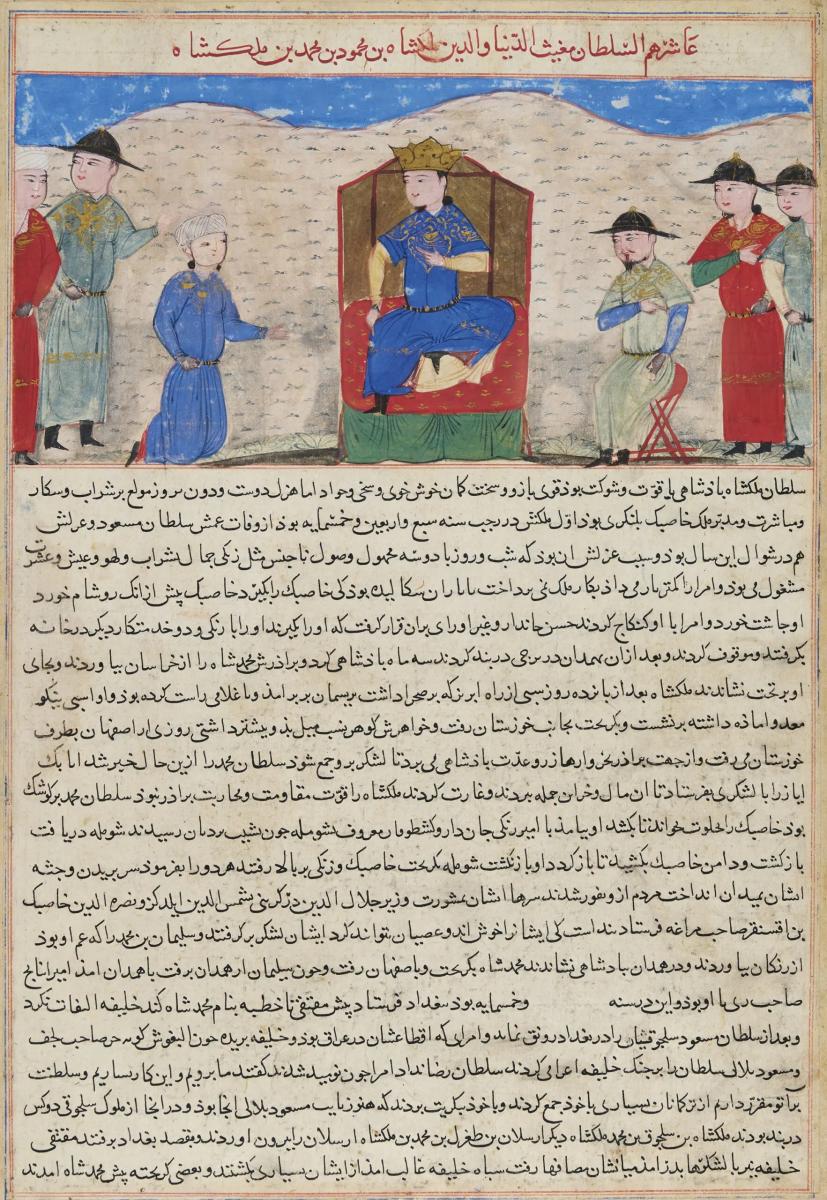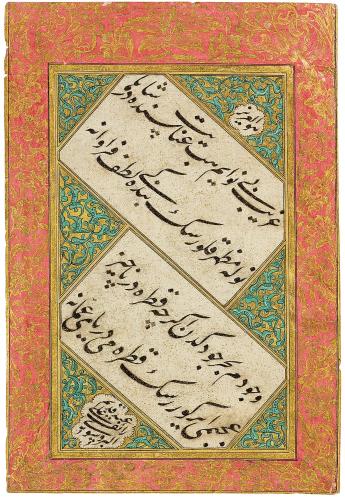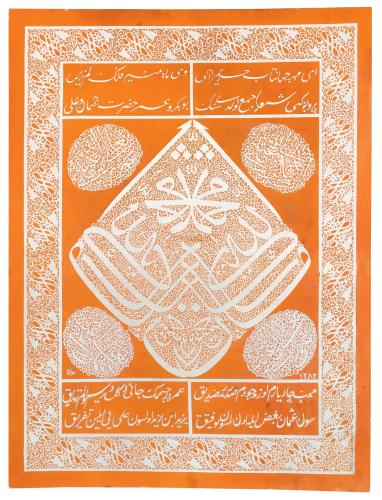

Price on application
This object is eligible for a Certificate of BADA Provenance
The BADA Standard
- Since 1918, BADA has been the leading association for the antiques and fine art trade
- Members are elected for their knowledge, integrity and quality of stock
- Our clients are protected by BADA’s code of conduct
- Our dealers’ membership is reviewed and renewed annually
- Bada.org is a non-profit site: clients deal directly with members and they pay no hidden fees
An Important Folio from Hafiz Abru’s Majma’ Al-Tawarikh Depicting The Great Seljuk Sultan Malik Shah III (R. 1152-1153).
Timurid.
Circa 1425.
Dimensions: Painting 14 x 25.5 cm. Page 43 x 33 cm.
The Seljuk ruler Sultan Malik Shah III (r. 1152-1153) enthroned in a landscape surrounded by viziers and courtiers, an illustration to the Majma‘ al-Tawarikh, Herat, c. 1425, gouache on paper with highlights in gold, written in twenty-one lines of black, red and blue naskh script, margins in black, naskh text on reverse.
The Text
Since time began, rulers across the globe have commissioned records of important events past and present. The Timurid dynasty, founded by Timur (Tamerlane) in 1370 was no exception with historians, scribes and artists fully occupied in the Timurid libraries and studios. Hence the Majma‘ al-Tawarikh (Histories of Glories) was commissioned and this particular folio depicts the Seljuk ruler Malik Shah III (r.1152-1153) whose short reign lasted barely a year. The unillustrated verso relates to the reign of his predecessor Sultan Mas’ud (r. 1134-1152).
There are two known copies of the Majma‘ al-Tawarikh. The first is in the Topkapi Palace Museum in Istanbul with the second, a dispersed copy, containing this particular folio and fitting in style to the painting of Herat, c. 1425. Opportunities to acquire Oriental manuscripts abounded at the beginning of the last century, often in Paris, with the likes of Demotte, Vever, Kevorkian and Tabbagh eager to add to their collections, with The Metropolitan Museum, The Walters Art Gallery and The Los Angeles County Museum being modern day recipients. Such opportunities are not as plentiful in the twenty-first century making this an exciting and rare occasion for the modern-day collector or institution.
The text on the reverse ends with the year 547 A.H. (1152 C.E.), the year Sultan Malik Shah III was enthroned. At the bottom of the page the names of Malik Shah’s viziers are listed as follows: Sharaf al-Din Anushirvan b. Khalid Kashi, Imad al-Din Abu al-Barakat Darguzini, Kamal al-Din Muhammad al-Hazin, Izz al-Mulk Barujurdi, Muayyad al-Din Tughrai, Taj al-Din Shirazi, Shams al-Din Abu-Najib, Manguvarir, Nanar, Abd al-Rahman, Khas-Beg Jangari.
The Author
The famed Timurid historian Hafez-e Abru (d. 1430) was tasked by Shahrukh (r. 1405-1447), Timur’s youngest son, with the commission of the Majma‘ al-Tawarikh, a continuation of the famous Jami‘ al-Tawarikh by the celebrated Ilkhanid historian-vizier Rashid al-Din. Hafez-e Abru was born in Khorasan and studied in Hamadan before moving to Herat where he flourished working for the Timurid court.
The Patron
The Timurid Empire spanning Central Asia controlled most of the main trade routes between Asia and Europe including the famed Silk Road, bringing great wealth to the region. The patron of the Jami‘ al-Tawarikh is Sultan Sharukh (r. 1405-1447). He established his capital in Herat rather than Timur’s Samarqand and with his third son Prince Baysunghur (1397-1434), and was an exceptional patron of the arts. Shahrukh was eager to commission histories of the Timurid ancestors and Baysunghur established an important library and atelier at Herat, worthy of Timur and his empire.
Further Reading:
- Binney, Islamic Art from the Collection of Edwin Binney, 3rd., Portland, 1962.
Ernst J. Grube, The World of Islam, London, 1966.
- W. Robinson, Rothschild and Binney Collections: Persian and Mughal Arts of the Book, Persian and Mughal Art, P & D Conaghi Exhibition Catalalogue, London, 1976, pp.13 and 22, no. 11.
Sotheby’s Sale of Fine Oriental Miniatures, Manuscripts, Qajar Paintings and Lacquer, London, 2 May, 1977, lot 164.
Abolala Soudavar, Art of the Persian Courts, New York, 1992, pp. 64-66.
On the reverse, the folio bears an old French customs stamp which reads “Douane Centrale”. This is the same stamp found on the folio from the Majma‘ al-Tawarikh, from the Emile Tabbagh collection, now preserved in the Smithsonian / Arthur M. Sackler Gallery / National Museum of Asian Art (Accession Number S1986.131). Please see, https://asia.si.edu/object/S1986.131/
Acknowledgment
We would like to thank Margaret Erskine for writing this article on the present folio from Hafiz Abru’s Majma‘ al-Tawarikh.
Provenance
Ex-Private French Collection, Poitiers.
The father of the French collector who owned this folio was actively collecting between 1920s and 1940s. They both were very connected to the Parisian artistic circles and the art market. It is not possible to give the precise date of the acquisition of the present folio, but since most pages from this famous manuscript appeared on the French market between 1928 and 1933, dispersed by the famous collector Emile Tabbagh, it was probably bought by the collector’s father during this period, in 1930s or 1940s. On the reverse, our folio bears an old French customs stamp which supports the Emile Tabbagh connection. This is the same customs stamp found on the folio from the Majma‘ al-Tawarikh, from the Emile Tabbagh collection, now preserved in the Smithsonian / Arthur M. Sackler Gallery / National Museum of Asian Art (Accession Number S1986.131). Please see, https://asia.si.edu/object/S1986.131/
The BADA Standard
- Since 1918, BADA has been the leading association for the antiques and fine art trade
- Members are elected for their knowledge, integrity and quality of stock
- Our clients are protected by BADA’s code of conduct
- Our dealers’ membership is reviewed and renewed annually
- Bada.org is a non-profit site: clients deal directly with members and they pay no hidden fees




![Rare Ottoman Calligraphy [Qit‘a] Signed Mehmed Shehri](/sites/default/files/styles/medium/public/object/2024-02-14/Rare%20Ottoman%20Calligraphy%20%5BQit%E2%80%98a%5D%20Signed%20Mehmed%20Shehri.jpg?itok=ZuiPb5qL)